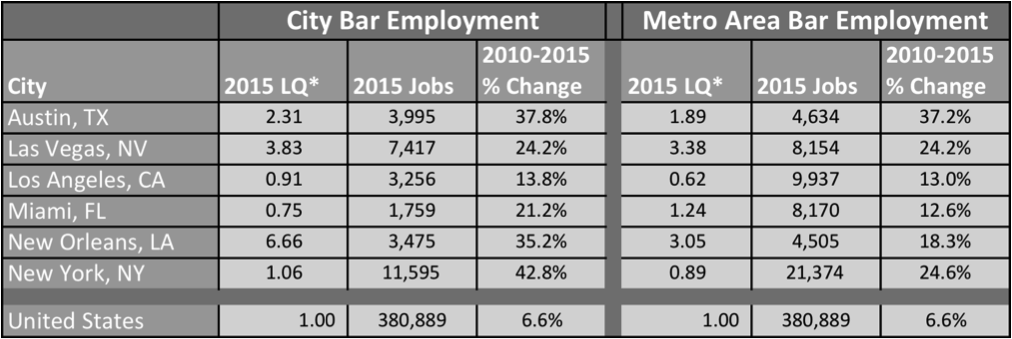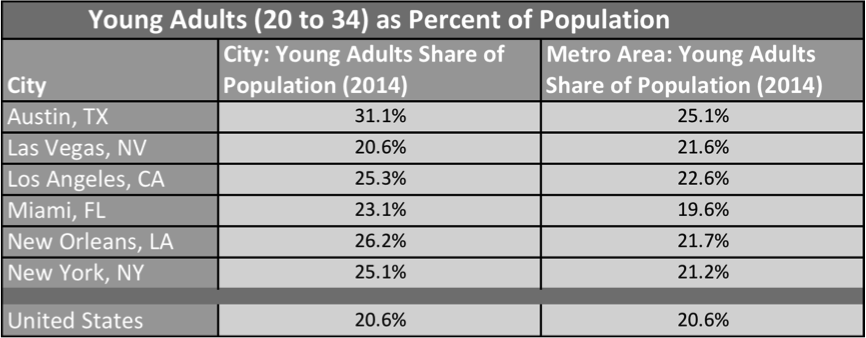The top party cities in the US are, in my opinion and not in order of priority:
- Austin
- Las Vegas
- Los Angeles
- Miami
- New Orleans
- New York
I’ve been wanting to put this list out for debate for quite a while. I hope you enjoy it. And most of all, I hope this sparks some debate. These are by no means the only cities with a thriving nightlife, just the top 6 in my humble opinion. I couldn’t go without doing a basic data analysis to explore the reality behind my claim (which you’ll find at the bottom of the page), but I chose these 6 cities prior to looking at any data.
First, here’s a quick qualitative overview of the 6 cities and why each should be considered one of America’s top party cities.
Austin has Sixth Street, which is the epicenter of a zip code that has more bars per person than any other zip code in the US as shown in this Austin Business Journal article. And the famous Sixth Street only refers to “Dirty Sixth” as the locals now call it because of the interesting combination of wild college kids, homeless people, and aggressive drunks from all walks of life. Don’t forget about West Sixth which is slightly more upscale, and East Sixth Street which is the ultimate hipster haven. Then you have the Warehouse District, the Rainey Street District, and the Red River District. And all that’s just in downtown proper. Beyond the urban core, you’ll find plenty of nightlife along South Lamar, South Congress, East Riverside, and even as far south as Way South Austin, anchored by the Moontower Saloon which is right across from my hood. Pound for pound, I wouldn’t doubt it if Austin has more vibrant nightlife districts than any other large city.
Las Vegas. Need we say more? This is actually the only city on the list I’ve yet to visit. Maybe a field visit for some qualitative data collection is in the cards 🙂 Seriously though, Las Vegas is known more than any other city as the place people will travel to for the sole purpose of letting loose. With many of the world’s largest hotels, the largest cluster of casinos in the US, and a 24/7 party mentality, Vegas has to be on any shortlist of the top party cities.
Los Angeles is where the biggest parties happen (Hollywood, the Playboy Mansion, you get the point). Los Angeles and Southern California are known across the US and worldwide for its sunny skies, mild weather, beaches, and its nightlife. SoCal is practically synonymous with what many people think of when they hear the term “living the good life”. And with good reason. Los Angeles is in a class all its own when it comes to celebrities, upscale nightclubs, and parties.
Miami and South Florida are probably right behind LA and SoCal in the “living the good life” index. Miami Beach (which is actually its own city, not the City of Miami, but part of the metro area) is a global destination for nightlife, drawing crowds of Europeans and Latin Americans to its beaches, bars, and nightclubs. Miami is also the prime party location for many New Yorkers and other Northeasterners who want to head to a beachfront hotspot to get a break from the cold weather in January and February.
New Orleans is the smallest city on this list, both the city proper and the metro area. But with Bourbon Street, Mardi Gras, and the French Quarter, it is undeniably one of the premier party cities. Funny story: During a recent visit to New Orleans I over heard a group of people chatting outside a bar next to Bourbon Street and my ears perked up when one of them mentioned Austin. Here is the unfiltered exchange: “Yeah, I’m from Austin. Austin?! I love Austin! It’s a lot like this [Bourbon Street, I assumed], but less dirty.” Bourbon Street is just a bit dirtier than Austin’s Dirty Sixth Street. Maybe it’s the dozen “gentlemen’s clubs” or the open carry laws across the city. No, not the firearm open carry that just passed the Texas legislature, the New Orleans-style open carry…alcohol containers 🙂 In any case, the food, music, and drinking in New Orleans make it a must-have on any list of the top party cities.
New York has earned it’s reputation as the “city that never sleeps” thanks to it’s dynamic party scene and nightlife. Whether you’re in the Meatpacking District, SoHo, the Lower East Side, or Williamsburg, there is no shortage of nightlife districts. Not to mention the countless celebrities that come here to party, or own their own nightclubs. I don’t know this for sure, but would bet that there are more nightlife districts in New York than in any city in North America, if not the world. There have to be dozens of well-established clusters of bars and nightclubs across the city, with new nightlife areas emerging every year.
What Does the Data Say?
Even though this blog post is not data-driven like most of the content on urbanSCALE, I did feel compelled to take at least a cursory quantitative look at these 6 party cities. So here’s a super simple analysis to help answer the question of whether these 6 cities should really be considered among the top party cities in the US. To keep things simple, I just chose two data points:
- The relative concentration of employment in bars, termed “drinking places (alcoholic beverages)” by the US Bureau of Labor Statistics; and
- The share of population in the 20-34 age cohort (this is not to say that people older or younger don’t party, but these are the typical peak partying years for most people)

Source: EMSI Complete Employment 2015.3. *LQ = Location Quotient. An LQ of 1.00 is equal to the national average. An LQ of 1.20 or higher indicates a relative concentration of jobs in a particular industry. An LQ of 0.80 or lower indicates a weak local industry.

Source: US Census Bureau, ACS 5-Year Estimates (2010-2014).
The data, for the most part, supports the claim that these 6 cities are top party cities. With the two largest cities (New York and Los Angeles), the data case is weaker, but within their respective metro areas they do have a much higher concentration of young adults and employment in bars. Miami also doesn’t appear quite as strong on this list either, partly because Miami Beach is such a major center of nightlife. Miami Beach has an LQ of 8.92 for bars with nearly 1,600 jobs compared to about 1,750 jobs in Miami’s bars. But the Miami area, including Miami Beach, is certainly a top party destination. And the data certainly support the case for Austin, New Orleans, and Las Vegas.
Even after looking at some data, I stand by my choices for all the qualitative reasons listed above. What do you think? I’d love to here your thoughts…




That is fascinating – I am glad you included the data as it helps support the argument that these are the top cities. While I was not surprised by Los Angeles, I feel like that should almost be excluded as it seems to pertain mainly to celebrities. A lot of the “parties” that exist (think of all the award ceremonies and after parties at swanky clubs) are really difficult for lay persons to access. However, your data is pretty clear – it just seems like a party city for those who are more affluent or who want to spend HOURS in line waiting to get in to an expensive club. You’re article was definitely fun and very interesting. I would be curious to see what the the list would read like if you included the top 10 cities (mainly cities 6-10). Thanks for the post, John!
Thank you for your comment, Cyndy! And good point about LA. The data doesn’t really support LA & NYC in the same way that it supports the other cities. Partly this is due to their size and diversity of the local economies. Sure, they both have lots of nightlife, but they have lots of everything!
Yes, it would be interesting to identify the next set of cities after these that are top party cities. In fact, here’s a recent post from Skyscanner called the 10 best nightlife cities in the US. I’m happy to report that it includes all 6 of my chosen cities! It also has Chicago, Nashville, Key West, and Providence. All of these make sense, but Providence is a bit of a surprise. I’ve been there but haven’t experienced the nightlife scene.
Hi John,
Great post! I can vouch for NYC and Austin. And although I’ve only visited LA, I’ve loved my time there. Problem is, you have to drive so far to get anywhere there. I think NYC has it in the bag (I know, I’m biased) because you don’t have to drive to get from point A to point B, so DWIs are not a problem. Uber has definitely changed the landscape on that count, of course, but there’s nothing cheaper than subway (or dirtier, unless you count Bourbon street, apparently :-).
Thank you for your comments, Tula! Yes, the entire nightlife scene is different now in less walkable cities thanks to Uber, Lyft, etc. Going out and not having to worry about driving after bar-hopping used to be something only urbanites in large cities with good transit systems could enjoy. Although, the Freakonomics guys have done some analysis that shows drunk walking is more dangerous than drunk walking on a per-mile basis!